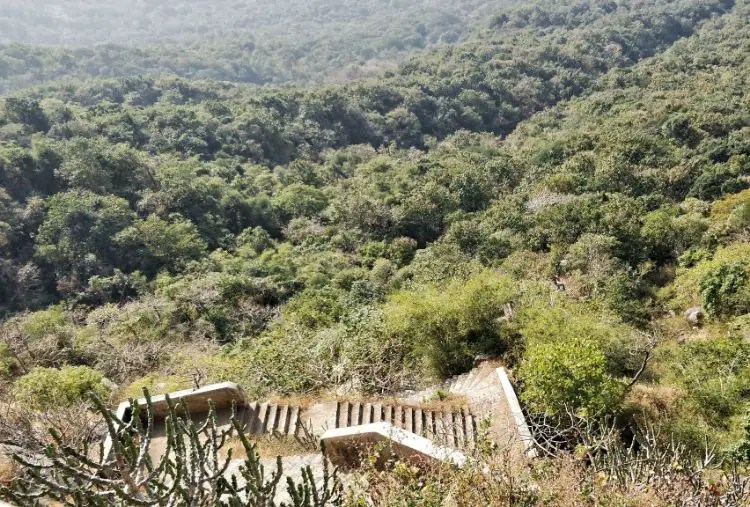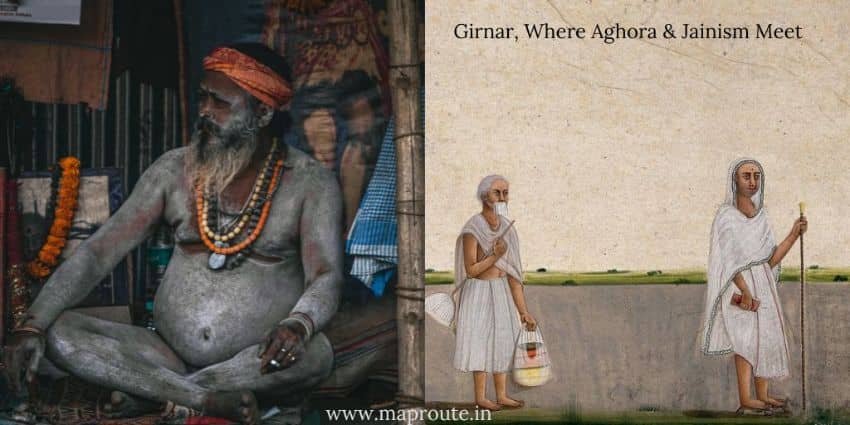On the spectrum of spiritual paths, the path of Aghora vs Jainism, are pretty much on opposite sides. One conjures the image of cremation grounds, ash covered folk and all things TABOO. The other brings to mind images of white clean marble temples, extreme non-violence and peace.
Robert Svoboda’s Aghora trilogy also brings the two together – Aghoris and Jains. The Aghori Vimalananda, Robert Svoboda’s mentor on whom the books are, got into his Aghora practices on behest of a particular (evil) Jain monk. This monk was an outlier amongst the usual Jain monks. But still, most Aghora books won’t mention Jainism at all, while this one does quite a bit in fact. Apart from this one evil monk, Vimalananda also mentions other thoughts and interactions with Jainism.
Aghora & Jainism on Girnar
As it happens, Girnar, the powerful and sacred mountain is a place where these two diverse clans meet. The sacred spot on the Girnar peak – where the current controversy between Jains and Hindus is also happening – is Neminath’s Nirvana place. Or Dattatreya’s place of significance?
The natural answer that comes to me is – BOTH! Probably, the spot itself is powerful. If you have been to Girnar, you may have felt the sacred pulsing vibe of the place and the ancient Gir forest surrounding this mountain. It is very natural for yogis and great beings to gravitate to such a space.
Neminath did most of his penance as a monk on Girnar. I have written more about that in this blog. He got enlightened there and left his body at the peak spot. The spot which is now the subject of the conflict.
Dattatreya, also is said to have done a lot of sadhana on this mountain. He is considered the founding Guru of the Aghori path.
Thus, it would be that the Jains and Aghoris both thrived at different times and eventually at the same time on this sacred mountain.
The Aghora Trilogy mentions quite a bit about the Aghoris on Girnar and the kinds of sadhana they did. However, the book also mentions that while Aghoris used to thrive in Girnar, once a group of Aghoris kidnapped a boy and killed him. This act got them into a lot of trouble and eventually they were doomed to dwindle away in Girnar. And thus, true Aghoris don’t go to Girnar anymore. Does this explain why the Aghori Jhuggi I visited in Girnar was empty?

Planning a trip to this sacred mountain? Here are my blog posts on the old & new pilgrimage route & Girnar Ropeway details.
Why Do Different Spiritual / Religious Groups Clash Like Hindus & Jains in Girnar?
Often when two different sadhana paths co-exist in close proximity, I feel strife happens largely due to two reasons,
Spiritual paths propound their SINGLE truth. This need not be a bad thing. As this helps, the followers stick to that one path and not pick and choose bits and pieces of different paths as per their own meager understanding. I elaborate more in this blog post about today’s cosmopolitan society that clashes with this one-mindedness needed on the spiritual path.
As the followers become single-focused on their own path, very few can remain non-judgemental about other paths. Inevitably, they become negative and judge the other paths to be WRONG or Misguided. When the other path like Aghora & Jainism are so different, almost opposite, then derision and negativity is bound. Moreover, even the few sadhakas who can maintain lack of negativity, they may still find that the different vibes being exuded does not support them.
Thus, it is not surprising they eventually clashed. Only when the clan leadership was more enlightened, they MAY have managed better. Because a genuine spiritual seeker, would not want to waste their energy opposing someone else. Rather focus on maintaining their sadhana best as they can.
These are my overall thoughts and understanding about this conflict and controversy. Though, of course, the conflict is not strictly between Aghoris and Jains. Rather the Guru Dattatreya temple management vs Jain sangha I think. At least, I see one court case between these.
The History of Jainism in Indian Subcontinent
One more important fact that matters here, I feel, is the rise of Jainism in India and then the fall. Around 2200 years ago, a little after Mahavir Swami’s nirvana, Jainism had spread across a large part of the Indian subcontinent. There has been bad blood between Hindus and Jains for sure in my opinion. Remnants of this historic conflict can be found in both groups of people, their inherent attitudes, their stories and their scriptural nudges. Thus, with this history, not only would the management and authorities be biased due to past mental conditioning. But the public are also biased to take sides, because they also have some inherent history of thinking against the other community.
Politics and vote bank appeasement is an ever present reality in today’s world, it would easily be another reason to make the situation worse.
What can be done about it? Is there a Solution to the Girnar Controversy?
Both communities must be able to worship the top sacred space. Allocate dedicated spaces. It may not be the exact location – if needed bar that exact spot for everyone
But allocate nearby space to both communities. Let them worship in their own way.
Technology can be harnessed to ensure that any offense committed in the space, can be recorded and relevant police action taken.
And obviously, some mediation efforts between both parties to foster harmony and progress. Sri Sri for Girnar?
What do you feel about it?

Leave a comment